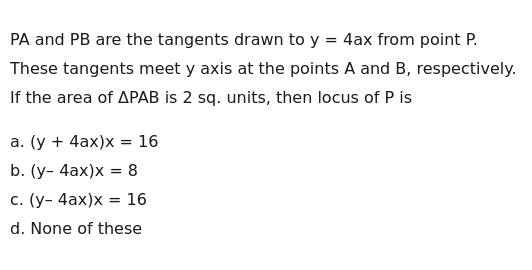Question
Question: PA and PB are the tangents drawn to y = 4ax from point P. These tangents meet y axis at the points A...
PA and PB are the tangents drawn to y = 4ax from point P. These tangents meet y axis at the points A and B, respectively. If the area of ΔPAB is 2 sq. units, then locus of P is

(y + 4ax)x = 16
(y– 4ax)x = 8
(y– 4ax)x = 16
None of these
(y– 4ax)x = 16
Solution
The given question has a likely typo in the equation of the parabola. Assuming the parabola is y2=4ax, similar to the provided example, we proceed as follows.
Let the point P be (x0,y0).
Let the tangents from P to the parabola y2=4ax touch the parabola at T1(x1,y1) and T2(x2,y2).
The equation of the tangent at a point (x′,y′) on the parabola y2=4ax is yy′=2a(x+x′).
The tangent PA from P(x0,y0) touches the parabola at T1(x1,y1). The equation of this tangent is yy1=2a(x+x1). Since it passes through P(x0,y0), we have y0y1=2a(x0+x1).
This tangent meets the y-axis at point A. Setting x=0 in the tangent equation, we get yy1=2ax1. So, the y-coordinate of A is yA=y12ax1. Since T1(x1,y1) is on the parabola, y12=4ax1, which implies x1=4ay12. Substituting this into the expression for yA, we get yA=y12a(y12/4a)=y1y12/2=2y1.
So, the point A is (0,y1/2).
Similarly, the tangent PB from P(x0,y0) touches the parabola at T2(x2,y2). The equation of this tangent is yy2=2a(x+x2). It passes through P(x0,y0), so y0y2=2a(x0+x2).
This tangent meets the y-axis at point B. Setting x=0, we get yy2=2ax2, so yB=y22ax2. Since y22=4ax2, we have x2=4ay22. Substituting this, we get yB=y22a(y22/4a)=2y2.
So, the point B is (0,y2/2).
The points forming the triangle are P(x0,y0), A(0,y1/2), and B(0,y2/2).
The base AB of the triangle lies on the y-axis. The length of the base is ∣yB−yA∣=∣2y2−2y1∣=21∣y2−y1∣.
The height of the triangle from P to the y-axis is the absolute value of the x-coordinate of P, which is ∣x0∣.
The area of △PAB=21×base×height=21×21∣y2−y1∣×∣x0∣=41∣x0(y2−y1)∣.
We are given that the area is 2 sq. units.
41∣x0(y2−y1)∣=2⟹∣x0(y2−y1)∣=8.
The points of tangency T1(x1,y1) and T2(x2,y2) are the intersections of the parabola y2=4ax and the chord of contact from P(x0,y0), whose equation is yy0=2a(x+x0).
From the chord of contact equation, x=2ayy0−2ax0. Substitute this into the parabola equation:
y2=4a(2ayy0−2ax0)=2(yy0−2ax0)=2yy0−4ax0.
y2−2y0y+4ax0=0.
The roots of this quadratic equation in y are y1 and y2, the y-coordinates of the points of tangency T1 and T2.
By Vieta's formulas:
y1+y2=2y0
y1y2=4ax0
We need ∣y2−y1∣. We can find (y2−y1)2:
(y2−y1)2=(y1+y2)2−4y1y2=(2y0)2−4(4ax0)=4y02−16ax0=4(y02−4ax0).
So, ∣y2−y1∣=4(y02−4ax0)=2∣y02−4ax0∣.
For real tangents to exist from P(x0,y0), P must lie outside or on the parabola, which means y02−4ax0≥0. Thus, ∣y02−4ax0∣=y02−4ax0.
∣y2−y1∣=2y02−4ax0.
Substitute this into the area equation ∣x0(y2−y1)∣=8:
∣x0∣(2y02−4ax0)=8.
∣x0∣y02−4ax0=4.
Squaring both sides:
x02(y02−4ax0)=16.
The locus of P(x0,y0) is obtained by replacing (x0,y0) with (x,y):
x2(y2−4ax)=16.
This equation can be written as x2y2−4ax3=16.
Let's check the given options, assuming the question meant y2=4ax.
a) (y+4ax)x=16⟹xy+4ax2=16
b) (y–4ax)x=8⟹xy−4ax2=8
c) (y–4ax)x=16⟹xy−4ax2=16
d) None of these
None of the options match the derived locus x2(y2−4ax)=16.
Let's re-examine the similar question's solution. The similar question involves y2=4x (so a=1) and the locus is a2(y2−4x)x2=16. Substituting a=1, we get 12(y2−4x)x2=16, which is x2(y2−4x)=16. This matches our derived locus for the general parabola y2=4ax with a=1.
So, if the parabola in the given question was y2=4ax, the locus is x2(y2−4ax)=16. This is not among the options.
Let's consider the possibility that the parabola is x2=4ay. We derived the locus x4(x2−4ay)=16a2 in the thought process. This is also not among the options.
Let's consider the possibility that the parabola is y=4ax. As discussed, this is a line, and tangents in the usual sense do not exist from an external point.
Given the context of JEE/NEET and conic sections, it is highly probable that the equation of the parabola is intended to be y2=4ax or x2=4ay. Since the similar question uses y2=4x, it is most likely that the intended parabola is y2=4ax. If the parabola is y2=4ax, the locus is x2(y2−4ax)=16. This is not in the options.
Given the high probability of a typo in the parabola equation in the question and the mismatch with the options, and the consistency of our derivation with the similar question's result (if the parabola was y2=4ax), it's highly likely that the question or options have errors.
However, if we are forced to choose from the given options, it suggests that either the problem is based on a different parabola or the options are incorrect, or there is a fundamental misunderstanding of the problem statement due to typos.
